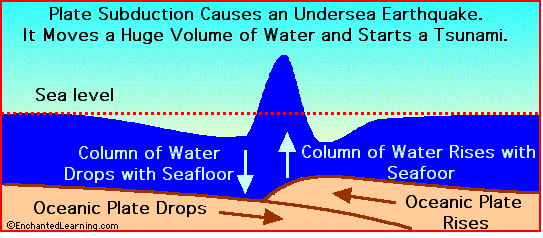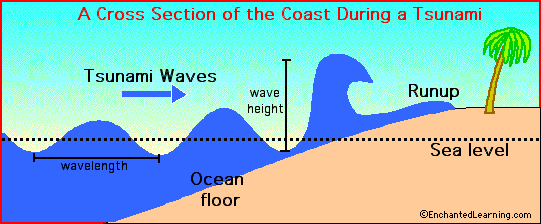
- •Environment and ecology Chapter 1
- •Chapter 2 Oceans. Natural parks and animals
- •The oceans
- •Why are the Oceans Salty?
- •Why is the ocean blue?
- •What Causes Waves?
- •What causes the tides?
- •Tsunami
- •Coral Reefs
- •National Parks and Climate Change
- •Animal invaders How much danger are we in? How many invaders are there?
- •Chapter 3 Atmosphere, climate and weather.
- •Chapter 4. Sustainable Development and Environmental Protection
Tsunami
A tsunami is a series of huge waves that can cause great devastation and loss of life when they strike a coast.
Tsunamis are caused by an underwater earthquake, a volcanic eruption, a sub-marine rockslide, or, more rarely, by an asteroid or meteoroid crashing into in the water from space. Most tsunamis are caused by underwater earthquakes, but not all underwater earthquakes cause tsunamis – an earthquake has to be over about magnitude 6.75 on the Richter scale for it to cause a tsunami. About 90 percent of all tsunamis occur in the Pacific Ocean.
Many tsunamis could be detected before they hit land, and the loss of life could be minimized, with the use of modern technology, including seismographs (which detect earthquakes), computerized offshore buoys that can measure changes in wave height, and a system of sirens on the beach to alert people of potential tsunami danger.
NOTE: If you see the water recede quickly and unexpectedly from a beach (this is called drawback), run toward higher ground or inland – there may be a tsunami coming. Also, if you are on the coast and there is an earthquake, it may have caused a tsunami, so run toward higher ground or inland. Some beaches have tsunami warning sirens – do not ignore them. The first wave in a tsunami is often not the largest; if you experience one abnormally huge wave, go inland quickly – even bigger waves could be coming soon.
The
word tsunami comes from the Japanese word meaning “
A tsunami starts when a huge volume of water is quickly shifted. This rapid movement can happen as the result of an underwater earthquake (when the sea floor quickly moves up or down), a rock slide, a volcanic eruption, or another high-energy event.
 After
the huge volume of water has moved, the resulting wave is very long
(the distance from crest to crest can be a hundred of miles long) but
not very tall (roughly 3 feet tall). The wave propagates (spreads)
across the sea in all directions; it can travel great distances from
the source at tremendous speeds.
After
the huge volume of water has moved, the resulting wave is very long
(the distance from crest to crest can be a hundred of miles long) but
not very tall (roughly 3 feet tall). The wave propagates (spreads)
across the sea in all directions; it can travel great distances from
the source at tremendous speeds.
Tsunamis have an extremely long wavelength (wavelength is the distance between the crest (top) of one wave and the crest of the next wave) – up to several hundred miles long. The period (the time between two successive waves) is also very long – about an hour in deep water.
In the deep sea, a tsunami’s height can be only about 1 m tall. Tsunamis are often barely visible when they are in the deep sea. This makes tsunami detection in the deep sea very difficult.
A tsunami can travel at well over 970 kph (600 mph) in the open ocean – as fast as a jet flies. It can take only a few hours for a tsunami to travel across an entire ocean. A regular wave (generated by the wind) travels at up to about 90 km/hr.

As a tsunami wave approaches the coast (where the sea becomes shallow), the trough (bottom) of a wave hits the beach floor, causing the wave to slow down, to increase in height (the amplitude is magnified many times) and to decrease in wavelength (the distance from crest to crest).
At landfall, a tsunami wave can be hundreds of meters tall. Steeper shorelines produce higher tsunami waves.
In addition to large tsunami waves that crash onto shore, the waves push a large amount of water onto the shore above the regular sea level (this is called run-up). The run-up can cause tremendous damage inland and is much more common than huge, thundering tsunami waves.
Tsunami warning systems exist in many places around the world. As scientists continuously monitor seismic activity (earthquakes), a series of buoys float off the coast and monitor changes in sea level. Unfortunately, since tsunamis are not very tall in height when they are out at sea, detection is not easy and there are many false alarms. Sirens at affected beaches may be activated – do not ignore them!
Regular waves (caused by the wind) are very different from tsunami waves. Tsunami waves are much faster than wind-generated waves and they have a much longer wavelength (the distance from crest to crest). In the deep sea, tsunami waves are very small, but by the coast, they dwarf regular waves.
Tsunamis are very rare. There are roughly six major tsunamis each century.
Most tsunamis are caused by an asteroid or meteoroid crashing into in the water from space, rarely, by underwater earthquakes.
Absolutely all underwater earthquakes cause tsunamis.
The first wave in a tsunami is often tremendous.
The sea floor quickly moves up or down and water is quickly shifted – it is the beginning of tsunami.
When the tsunamis are in the deep sea they are often barely visible.
When the tsunami approaches the shore, the wave spreads across the sea only in one direction.
Detection of tsunami is not easy.
There are more real alarms of tsunami than the false alarms.
7.6 Write your own definition of tsunami.
7.7 Describe the pictures from the text.
(Based on http://www.enchantedlearning.com/subjects/tsunami/)
Task 8. Read the text and underline the correct verb form choosing one from the variants given:
